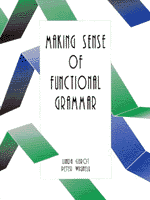Linda Gerot and Peter Wignell outline the function of relational, identifying, and attributive processes in their explication of reports.

Social Function
To describe the way things are, with reference to a range of natural, man-made and social phenomena in our environment
Generic (Schematic) Structure
General Classification: tells what the phenomenon under discussion is Description: tells what the phenomenon under discussion is like in terms of
- parts (and their functions)
- qualities
- habits or behaviours, if living; uses, if non-natural
Significant Lexicogrammatical Features
Focus on Generic Participants (in bold)
Use of Relational Processes (in italics) to state what is and that which it is
Use of simple present tense (unless extinct)
No temporal sequence
Whales
General Classification
Whales are sea-living mammals.
Description: (behaviours, qualities, parts)
They therefore breathe air but cannot survive on land. Some species are very large indeed and the blue whale, which can exceed 30m in length, is the largest animal to have lived on earth, Superficially, the whale looks rather like a fish, but there are important differences in its external structure: its tail consists of a pair of broad, flat, horizontal paddles (the tail of a fish is vertical) and it has a single nostril on top of its large, broad head. The skin is smooth and shiny and beneath it lies a layer of fat (blubber). This is up to 30cm in thickness and serves to conserve heat and body fluids.
Analytical Exposition
Social Function
To persuade the reader or listener that something is the case
Generic (Schematic) Structure
• Thesis
Position: introduces topic and indicates writer’s position
Preview: outlines the main arguments to be presented
…
Relational Processes: Processes of Being and Having
Relational Processes involve states of being (including having). They can be classified according to whether they are being used to identify something (Barry Tuckwell may be the finest living horn player) or to assign a quality to something (Barry Tuckwell is a fine horn player).
Processes which establish an identity are called Identifying Processes and Processes which assign a quality are called Attributive Processes. Each has its own characteristic Participant roles. In Attributives these are Carrier and Attribute.
Barry Tuckwell is
a fine horn player
Carrier Attributive Attribute
In Identifying Processes the Participant roles are Token and Value.
Barry Tuckwell may be
the finest living horn player
Token Identifying Value
…
Relational Processes play a key role in education in subjects such as science, geography, mathematics and economics. It is through these Processes that these subjects create an ordered technical vocabulary, and a way of classifying the world. They are fundamental in how the above-mentioned subjects construct the world.
It is sometimes difficult to tell whether a Relational Process is Identifying or Attributive. Perhaps the easiest way to distinguish between them is that Identifying Processes are reversible. That is, the clause can be reversed in order and the semantic relationship still holds. For example:
Barry Tuckwell may be
the finest living horn player
Token ldentifying:intensive Value
The finest living horn player
may be Barry Tuckwell
Value ldent:intens. Token
In each case the role (the finest living horn player) and the occupant (Barry Tuckwell) are the same.
If we take a difficult case such as:
A whale is
a mammal
Carrier Attributive:intensive Attribute
we find that, while it is reversible—a mammal is a whale—the relationship does not hold from the original. That is, while all whales are mammals, all mammals are not whales, as ‘a mammal is a whale’ suggests. The clause— a whale is a mammal—is assigning class membership, not identification.
The reversibility test works because Identifying Processes have a passive voice; that is, the clause can be made passive. However, is does not change its form when it is passive so a further test is to substitute a Relational Process which does change. For example:
The nucleus The nucleus
is comprises
the brain of the cell the brain of the cell
Token ldentifying:intens Value
The brain of the cell is comprised of the nucleus
value Identuntens. Token
…
Halliday defines Value as the referent, function or status, and Token as the sign, name, form, holder, occupant, In general terms, the Value will be more abstract, general and will provide the category. Token is more concrete, more specific and provides the instance.
Gerot, Linda & Wignell, Peter. 1995. Making Sense of Functional Grammar: An Introductory Workbook. Cammeray, NSW: Antipodean Educational Enterprises. pp. 196-197, 67-70. || Amazon || WorldCat
